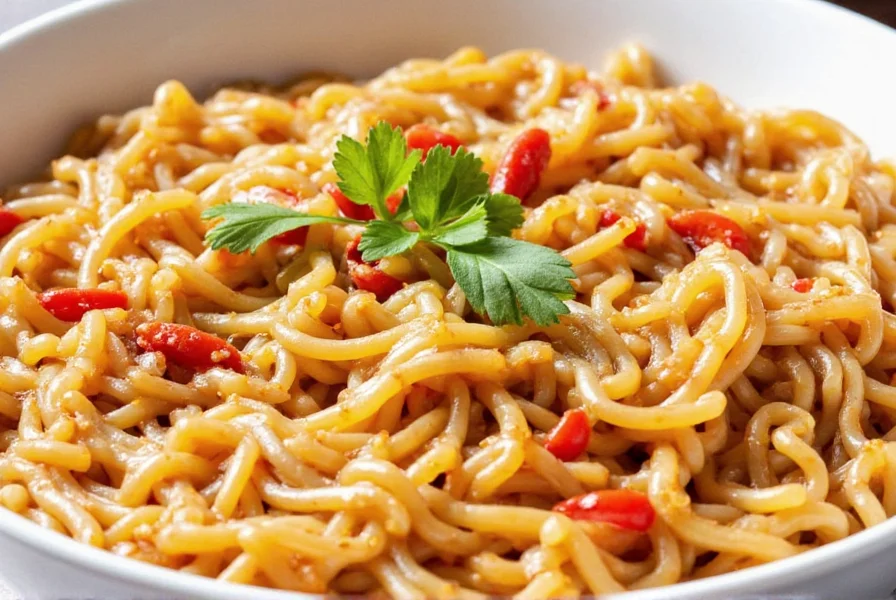What is Oriental flavored ramen? This guide explains the authentic meaning behind "Oriental" seasoning, its cultural context, and how to make the most of your instant ramen experience with practical tips for customization, spice control, and healthy modifications.
| Spice Level | Scoville Units | Typical Ingredients | Recommended For |
|---|---|---|---|
| Mild | 0–1,000 SHU | Soy sauce, miso, ginger | Beginners, kids, sensitive palates |
| Medium | 1,000–10,000 SHU | Crushed red pepper, gochugaru | Casual spice lovers |
| Hot | 10,000–50,000 SHU | Chili oil, tabasco, cayenne | Experienced heat seekers |
| Extreme | 50,000+ SHU | Ghost pepper, Carolina Reaper | Pro spice warriors only |
| Brand | Flavor | Heat Level | Key Features | Best For |
|---|---|---|---|---|
| Maruchan Oriental | Classic Soy-Garlic | Mild | Well-balanced flavor, widely available | Everyday eaters |
| Samyang Buldak | Fire Chicken | Extreme | Super spicy, chewy texture | Heat junkies |
| Nongshim Shin | Spicy Seafood | Hot | Rich, savory broth with seafood bits | Seafood lovers |
| Paldo Bibim Men | Spicy Stir-Fried | Medium-Hot | Dry, stir-fry style with gochujang | Lunch cravings |
| Cup Noodles Sapporo Ichiban | Shoyu | Mild | Light yet flavorful, perfect for travel | On-the-go meals |
Understanding "Oriental" Flavor in Ramen
The term "Oriental" in ramen seasoning has historical context but is increasingly considered outdated and potentially problematic. Originally used in Western marketing to describe East Asian flavors, it lacks cultural specificity and can perpetuate stereotypes. Most "Oriental" flavored ramen in Western markets is an Americanized interpretation of Asian flavors, typically featuring soy sauce, garlic, sesame oil, and ginger.
Authentic Japanese or Korean ramen has much more complex broths with regional variations. Modern brands are moving toward more specific descriptors like "Soy-Garlic" or "Asian-Inspired" to better represent the flavors without relying on outdated terminology.
How to Customize Oriental Flavored Ramen
Instant ramen is incredibly versatile. Here's how to transform it from a quick meal into a gourmet experience:
- Reduce Saltiness: Use only half the seasoning packet, add more water or broth, or include acidic elements like rice vinegar or lime juice to balance flavors.
- Upgrade Your Broth: Replace water with chicken, vegetable, or bone broth for richer flavor. Add a splash of coconut milk for creaminess.
- Add Fresh Vegetables: Bok choy, mushrooms, spinach, bean sprouts, and green onions add texture and nutrients. Add delicate greens at the end of cooking.
- Boost Protein: Cooked shrimp, grilled tofu, sliced pork belly, or shredded chicken breast elevate the meal from snack to full course.
- Make It Healthy: Use whole grain noodles when available, skip the oil packet, and boost with homemade broth instead of water.
Frequently Asked Questions
What exactly is "Oriental flavor" in ramen?
"Oriental flavor" typically refers to a savory soy sauce-based seasoning with garlic, sesame oil, and ginger. Despite the somewhat outdated term, it's meant to evoke traditional East Asian flavors, particularly Japanese and Chinese cooking styles. The flavor profile is usually salty, umami-rich, and mildly aromatic without being overly spicy.
How can I make my Oriental ramen less salty?
To reduce saltiness in Oriental ramen: 1) Use only half the seasoning packet, 2) Add more water or broth to dilute, 3) Include acidic elements like rice vinegar or lime juice to balance flavors, 4) Add vegetables which can absorb some salt, or 5) Choose low-sodium versions when purchasing.
Is Oriental flavored ramen actually Asian-inspired?
While marketed as "Oriental," most Oriental flavored ramen is an Americanized interpretation of Asian flavors. Traditional Japanese or Korean ramen has much more complex and region-specific broths. The "Oriental" flavor common in Western markets is typically a simplified soy-garlic-sesame profile designed for broad appeal.
What are the best vegetables to add to Oriental ramen?
Excellent vegetable additions include: bok choy (adds freshness), mushrooms (boosts umami), spinach or kale (adds nutrients), bean sprouts (provides crunch), bamboo shoots (traditional Asian ingredient), and green onions (for garnish). Add delicate greens at the end of cooking, while heartier vegetables like mushrooms should be cooked with the broth.
Can I make Oriental ramen without the seasoning packet?
Absolutely! You can create your own Oriental-style broth using: 2-3 cups of broth or water, 1-2 tablespoons soy sauce, 1 teaspoon sesame oil, 1 clove minced garlic, 1/2 teaspoon grated ginger, and optional red pepper flakes for heat. This gives you complete control over ingredients and sodium levels.
Why is it called "Oriental" flavor and is that term problematic?
The term "Oriental" has fallen out of favor as it's considered outdated and potentially offensive when referring to people or cultures. Many brands are now changing to more specific terms like "Soy-Garlic" or "Asian-Inspired." The term originated from Western marketing in the mid-20th century as a catch-all for Eastern flavors but lacks cultural specificity and can perpetuate stereotypes.
How long should I cook Oriental ramen for the perfect texture?
For ideal texture, cook ramen noodles for 2-3 minutes for soft noodles, or 1-2 minutes for firmer, chewier noodles. Always check package instructions as cooking times vary by brand. For restaurant-quality results, cook noodles separately from the broth, then rinse briefly in cold water before adding to hot broth to prevent overcooking.
What are the healthiest ways to enjoy Oriental ramen?
To make Oriental ramen healthier: 1) Use half the seasoning packet, 2) Add plenty of vegetables for nutrients, 3) Include lean protein sources, 4) Skip the oil packet or use a healthier oil alternative, 5) Choose whole grain or vegetable-based noodles when available, and 6) Boost broth with homemade bone broth or vegetable stock instead of water.
Oriental flavored ramen is more than just a quick meal—it's a customizable culinary experience. By understanding the cultural context of the term "Oriental" and learning how to properly customize your bowl, you can transform instant ramen into a nutritious, flavorful dish that respects its Asian culinary roots.











 浙公网安备
33010002000092号
浙公网安备
33010002000092号 浙B2-20120091-4
浙B2-20120091-4